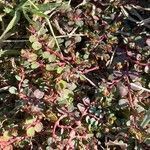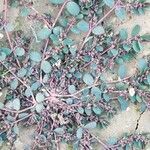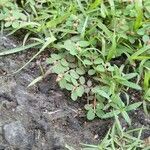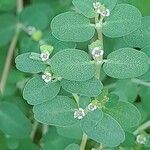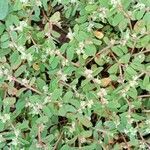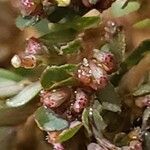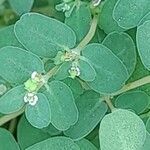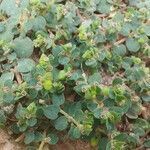Annual much-branched herb, prostrate, with branches to 10(–20) cm. long, the whole plant completely glabrous.. Leaves subcircular, 1–3 mm. in diameter, base obliquely cordate, margin entire; petiole 0.2–0.5 mm. long; stipules united at the swollen nodes, triangular, ± 0.5 × 1 mm., with toothed margin.. Cyathia solitary on peduncles to 2 mm. long, terminal and pseudoaxillary on short leafy shoots, ± 0.7 × 0.7 mm., with cup-shaped involucres; glands 4, minute, transversely elliptic, with small white shallowly lobed petaloid appendages; involucral lobes minute, margin fringed.. Male flowers: bracteoles laciniate; stamens 0.7 mm. long.. Female flower: perianth evident as a 3-lobed rim below the shortly pedicellate ovary; styles 0.2 mm. long, spreading, bifid almost to the base.. Capsule exserted on a reflexed pedicel to 1.8 mm. long, obtusely 3-lobed, with truncate base, ± 1.5 × 1.8 mm., yellowish green.. Seeds oblong-conical, 1 × 0.6 mm., greyish pink, smooth.
Herbs, annual, 15-20 cm tall. Root fibrous, 1-2 mm, branched or not. Stems many from base, prostrate, 1-2 mm thick, internodes with adventitious roots, often green, sometimes purple striate, glabrous. Leaves opposite; stipules membranous, triangular, caducous; petiole ca. 1 mm; leaf blade oblong, 2-5 × 1.5-3 mm, gray-green pilose, base truncate or cordate, margin entire. Cyathia single, axillary; involucre turbinate to campanulate, 0.5-0.7 × 0.4-0.5 mm, glabrous, marginal lobes 4; glands 4, reniform-rounded, appendages white, longer and wider than glands. Male flowers 3-5, usually not exserted. Female flower: pedicel ca. 0.5 mm; exserted from involucre; ovary smooth, glabrous; styles free; stigma deeply 2-lobed. Capsule subglobose, 1.5-1.8 × 1.6-1.9 mm, smooth, glabrous; fruiting pedicel ca. 2 mm. Seeds oblong-ovoid, 0.9-1.1 × 0.6-0.9 mm, gray to brown, often smooth, sometimes furrowed; caruncle absent. Fl. and fr. Mar-Aug.
Glabrous annual; stems prostrate, freely branched, 1-4 dm, the internodes of the branches very short and the plants thus very leafy; lvs broadly oblong to suborbicular, 2-7 mm, entire; stipules united into a scale-like structure often lobed or fringed at the tip; appendages very small; fr 3-angled, 1-1.5 mm; seeds quadrangular, smooth, 1 mm. Moist alluvial soil; s. Ont. to Mont., s. to Tenn., Fla., Ariz., and trop. Amer., and intr. here and there eastward. July-Oct. (Chamaesyce s.)
Cyathia terminal and pseudoaxillary on short leafy shoots, solitary on peduncles to 2 mm long, 0.7 × 0.7 mm with cup-shaped involucres; glands 4, minute, transversely elliptic, with small white shallowly lobed appendages; involucral lobes minute, fringed.
Leaves with a petiole 0.2–0.5 mm long; stipules united at the swollen nodes, 0.5 × 1 mm, triangular with toothed margins; lamina 1–3 mm long, subcircular, obliquely cordate at the base, margins entire.
Female flower: perianth evident as a 3-lobed rim below the shortly pedicellate ovary; styles 0.2 mm long, spreading, bifid almost to the base.
Capsule exserted on a reflexed pedicel to 1.8 mm long, 1.5 × 1.8 mm, obtusely 3-lobed with truncate base, yellowish-green.
Much-branched prostrate annual herb, with branches to 10(20) cm long, completely glabrous.
Male flowers: bracteoles laciniate; stamens 0.7 mm long.
Seeds 1 × 0.6 mm, oblong-conical, smooth, greyish-pink.
